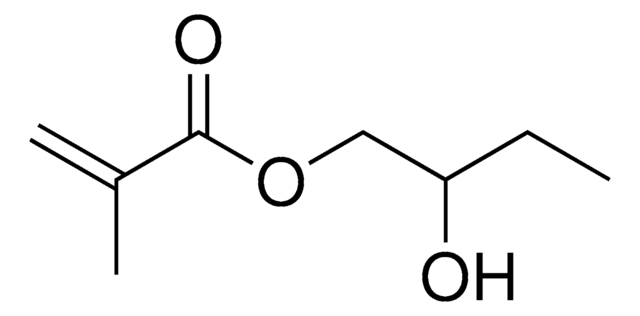128635
2-Hydroxyethyl methacrylate
contains ≤250 ppm monomethyl ether hydroquinone as inhibitor, 97%
Synonim(y):
1,2-Ethanediol mono(2-methylpropenoate), Glycol methacrylate, HEMA
About This Item
Polecane produkty
gęstość pary
5 (vs air)
ciśnienie pary
0.01 mmHg ( 25 °C)
Próba
97%
Postać
liquid
zawiera
≤250 ppm monomethyl ether hydroquinone as inhibitor
współczynnik refrakcji
n20/D 1.453 (lit.)
tw
67 °C/3.5 mmHg (lit.)
gęstość
1.073 g/mL at 25 °C (lit.)
temp. przechowywania
2-8°C
ciąg SMILES
CC(=C)C(=O)OCCO
InChI
1S/C6H10O3/c1-5(2)6(8)9-4-3-7/h7H,1,3-4H2,2H3
Klucz InChI
WOBHKFSMXKNTIM-UHFFFAOYSA-N
Szukasz podobnych produktów? Odwiedź Przewodnik dotyczący porównywania produktów
Powiązane kategorie
Opis ogólny
Zastosowanie
Hasło ostrzegawcze
Warning
Zwroty wskazujące rodzaj zagrożenia
Zwroty wskazujące środki ostrożności
Klasyfikacja zagrożeń
Eye Irrit. 2 - Skin Irrit. 2 - Skin Sens. 1
Kod klasy składowania
10 - Combustible liquids
Klasa zagrożenia wodnego (WGK)
WGK 1
Temperatura zapłonu (°F)
222.8 °F - closed cup
Temperatura zapłonu (°C)
106 °C - closed cup
Certyfikaty analizy (CoA)
Poszukaj Certyfikaty analizy (CoA), wpisując numer partii/serii produktów. Numery serii i partii można znaleźć na etykiecie produktu po słowach „seria” lub „partia”.
Masz już ten produkt?
Dokumenty związane z niedawno zakupionymi produktami zostały zamieszczone w Bibliotece dokumentów.
Klienci oglądali również te produkty
Produkty
Monomers for ophthalmic use aim for purity, reliability, and comfort, driving innovation for affordable contact lenses.
Nasz zespół naukowców ma doświadczenie we wszystkich obszarach badań, w tym w naukach przyrodniczych, materiałoznawstwie, syntezie chemicznej, chromatografii, analityce i wielu innych dziedzinach.
Skontaktuj się z zespołem ds. pomocy technicznej












